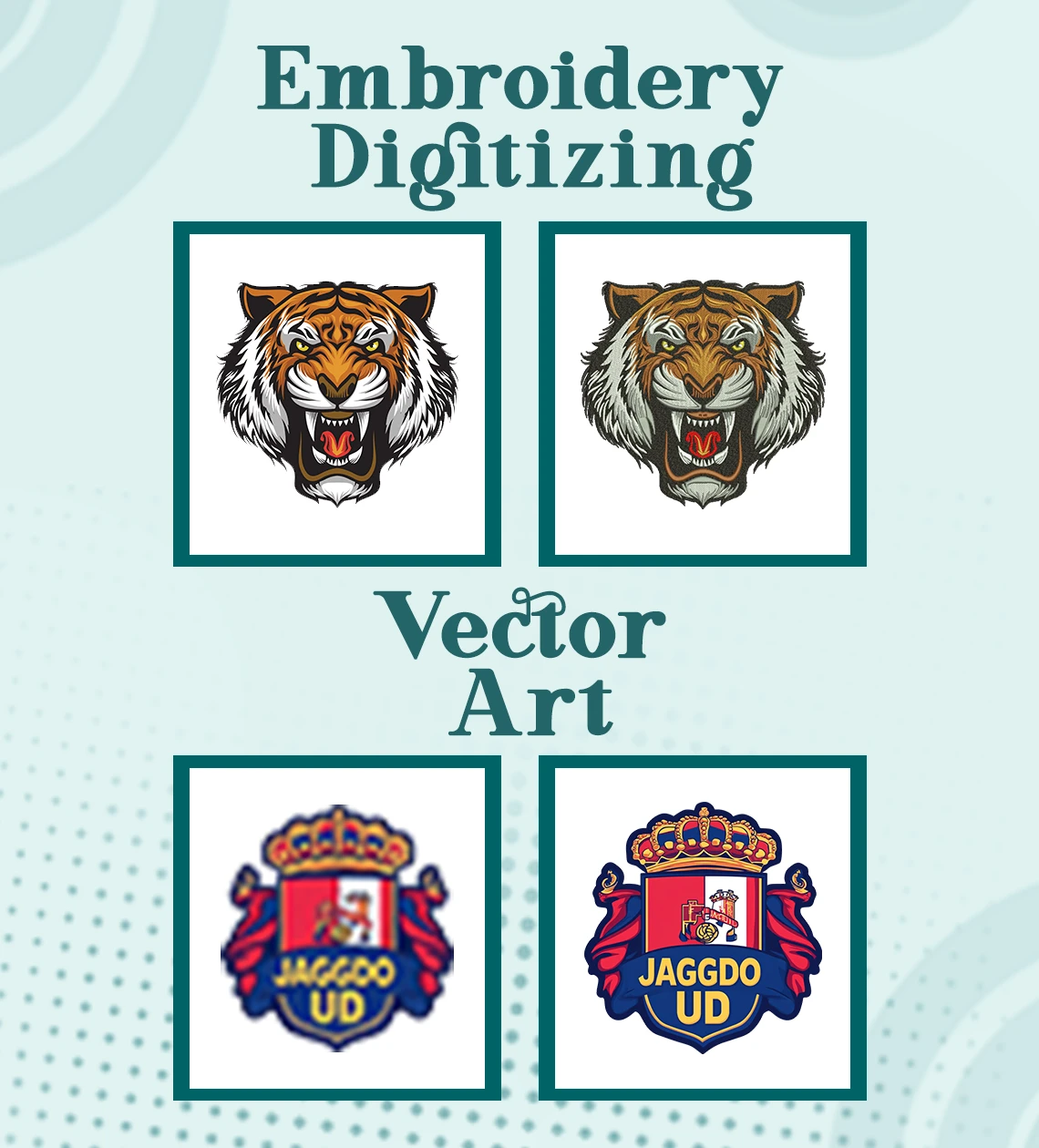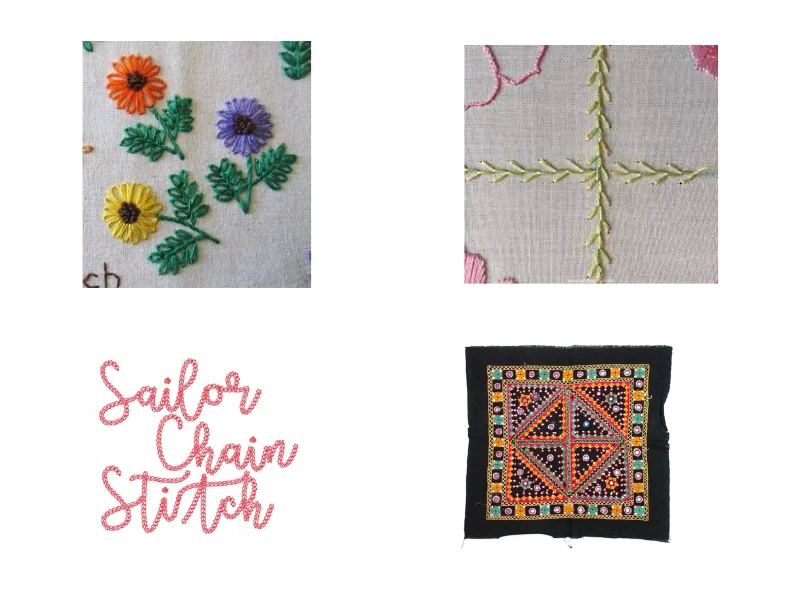
The chain embroidery stitch is one of the simplest and most visually appealing embroidery techniques. Its interconnected loops provide a textured chain-like look, making it popular among freshers and experienced embroiderers.
Here’s how to form a loop and work your first chain stitch:
Prepare the Fabric and Hoop: Stretch the fabric tight in an embroidery hoop, making sure it is secure and smooth for even tension.
Thread Your Needle: Use embroidery floss or thread that suits your design. Tie a small knot at the end for stability.
Start the Stitch: Move the needle from the back of the fabric to the right side, pulling it all the way through.
Create the Loop: Move the needle back into the same hole (or slightly next to it) to form a loop. Hold the loop gently with your thumb.
Anchor the Loop: Bring the needle up through the fabric inside the loop to secure it, forming a clean chain link.
Repeat: Continue this process, keeping the tension consistent to ensure uniformity.
By working the chain stitch from top to bottom or left to right, you can make various patterns and flow directions. With practice, this stitch becomes as second nature as a running stitch.
Check out this blog post: basic embroidery stitches
To get started with chain embroidery stitch, gather the following essentials:
Fabric: Cotton, linen, or any smooth fabric that suits your design.
Embroidery Hoop: Keeps the fabric steady and tight, making the stitching process easier.
Embroidery Needle: A sharp or blunt needle, depending on the fabric.
Embroidery Floss: Typically six-strand floss, though you can adjust the thickness based on your project.
Scissors: A sharp pair for precise thread cutting.
These essential materials ensure a smooth stitching experience, helping you to focus on creating fun and colorful designs.
At True Digitizing, we offer quick turnaround times, guaranteed quality, and the option to preview your design before making a payment. We ensure you get exactly what you need. We are committed to delivering the best results every time. What are you waiting for? Contact True Digitizing today and experience the difference in quality and service.

Chain embroidery stitch has evolved into numerous forms, each has a distinct texture and design. Here’s a handy list of popular variations:
Basic Chain Stitch: A basic stitch, perfect for beginners and versatile enough for most designs.
Twisted Chain Stitch: Twisted chain stitch adds a spiral effect by twisting the thread, giving a textured and intricate look.
Detached Chain Stitch (Lazy Daisy): A free-form variation often used for floral designs and petals.
Heavy Chain Stitch: A bold stitch good for outlining or decorative details.
Double Chain Stitch: Features two parallel rows of interlinked loops, adding dimension and depth.
Each stitch uses unique techniques to improve your designs. Whether you’re stitching for decor or garments, these variations add versatility to your embroidery options.
Check out this blog post: types of embroidery stitches
Understanding the chain embroidery stitch requires consistent technique and creativity. Below are some tips to refine your skills:
Consistent Tension: Maintaining even tension is key to achieving polished and professional-looking stitches.
Flow and Direction: Know your stitch direction, whether it’s left to right or another pattern, for a smooth design.
Experiment with Threads: Incorporate metallic or variegated floss for a lovely, textured effect.
Layering Stitches: Combine chain stitch with satin stitch or buttonhole stitch for added depth and detail.
These techniques make the chain embroidery stitch more attractive, helping you to explore creative possibilities for every project.
The detached chain stitch, commonly referred to as Lazy Daisy, is the best starting point. This free-form variation is good for creating petals, leaves, and loops.
Steps to create Lazy Daisy:
Move the needle up to the fabric’s right side at the starting point.
Pull it back into the same hole, leaving a loop on the surface.
Anchor the loop with a tiny straight stitch at the tip.
This stitch is not only simple but also fun and colorful, making it perfect for beginners exploring hand embroidery.
Watch this tutorial if want to learn more.
For beginners, starting with the basic chain stitch is important. Once comfortable, try experimenting with the twisted chain stitch or Lazy Daisy. These are unique and handy stitches that allow you to add unique details to your designs.

The chain stitch unlocks a world of creative possibilities. Here are some inspiring design ideas:
Floral Patterns: Combine Lazy Daisy with French knots for intricate floral patterns.
Borders and Edges: Use twisted chains or heavy chain stitches to outline designs.
Monograms and Lettering: Add texture and elegance to initials or phrases.
Geometric Shapes: Experiment with vibrant colors and shapes for a modern touch.
With chain stitch embroidery, you can turn any idea into a wonderfully crafted masterpiece.
Embroidery chain stitch combines tradition with creativity, making it an essential skill for every embroidery lover. Whether you’re creating bold outlines or delicate patterns, this versatile stitch empowers you to transform simple fabrics into stunning designs.
At True Digitizing, we specialize in transforming your artistic visions into digital embroidery work. Let us help you boost your projects with precision and expertise. Explore our embroidery digitizing services today and bring your designs to life.
Nick William has been immersed in the world of embroidery digitizing for over 20 years, earning 25 industry awards throughout his career. As a 3rd generation embroidery expert, Nick’s journey started in his family’s workshop, where he learned the art of digitizing before the rise of modern software. He has worked with leading commercial embroidery businesses and has shared his expertise with over 75,000 home and professional embroiderers. As an author at True Digitizing, Nick is passionate about teaching others how to create beautiful, precise designs through easy-to-follow tutorials and expert advice.
Categories

6 Popular Types of Vector Files 2025
16-04-2025

How To Create A Vector File: Step-by-Step Guide
15-04-2025

What Is A Vector File? Everything You Need To Know
14-04-2025

Best Janome Embroidery Machines You Need to Check Out in 2025
11-04-2025

Custom Embroidery Digitized Designs For Hoodie Lovers
10-04-2025

Best Embroidery Patches For Your Clothes
10-04-2025

Professional Online Photo Digitizing Services Provided by True Digitizing
09-04-2025

Best Babylock Embroidery Machines For You
09-04-2025

Barudan Embroidery Machines: From Beginners to Professionals
04-04-2025

Custom Sweatshirt Embroidery Digitized Designs By True Digitizing
03-04-2025